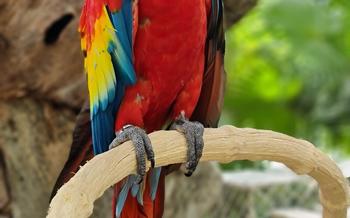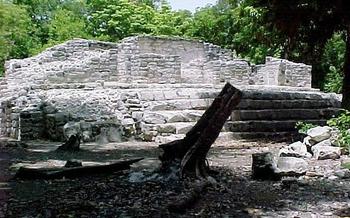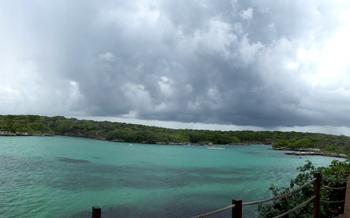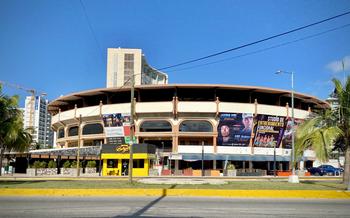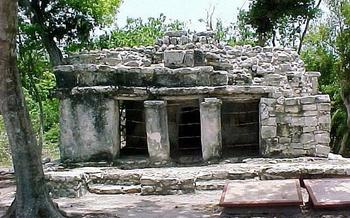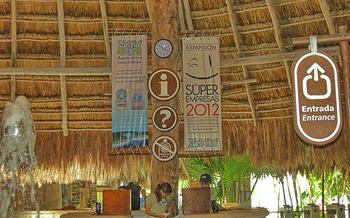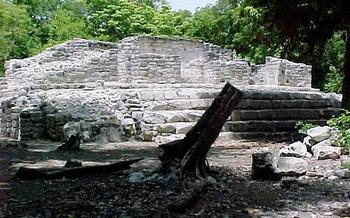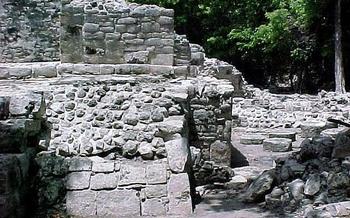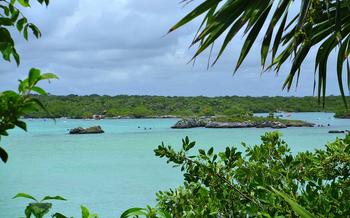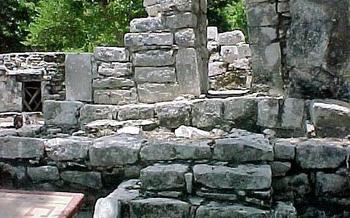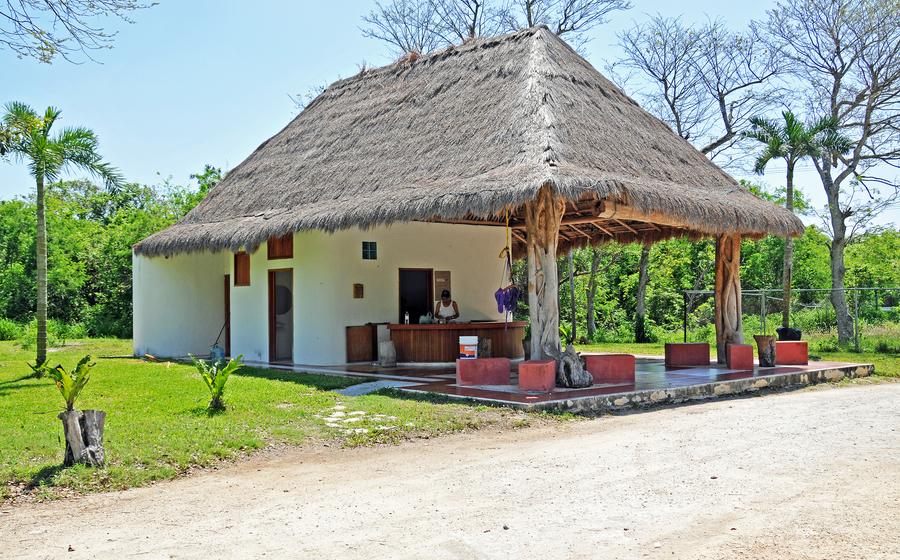
El Rey Ruins (Zona Arqueológica El Rey)
- Xel-Ha: A Snorkeler's Paradise
- Getting to El Rey Ruins
- Exploring the Ruins
- The Temple of the Birds
- The Ballcourt
- The Palace
- The Stelae
- The Residential Areas
- The Cenotes
- The Museum
- The Natural Surroundings
- Tips for Visitors
- Photography at El Rey Ruins
- Insider Tip: Exploring the Surroundings
Xel-Ha: A Snorkeler's Paradise
Xel-Ha, a natural aquarium located in the Riviera Maya, is a snorkeler's paradise, renowned for its crystal-clear waters, vibrant coral reefs, and an abundance of marine life. This unique ecosystem, once a sacred site for the ancient Mayans, is now a popular destination for snorkeling enthusiasts worldwide.
The historical significance of Xel-Ha dates back to the Mayan civilization, who revered it as a place of worship and pilgrimage. Archaeological evidence suggests that the site was a major trading hub and a center for religious ceremonies. Today, visitors can still admire the remnants of Mayan structures, including a small temple and several platforms, which add to the site's cultural significance.
Conveniently situated just a short distance from Cancun and Playa del Carmen, Xel-Ha offers easy access to snorkeling enthusiasts. The calm waters and excellent visibility make it an ideal spot for both beginners and experienced snorkelers. The site boasts over 90 species of fish, including colorful parrotfish, angelfish, and damselfish, as well as sea turtles, rays, and even the occasional dolphin.
For those seeking a more immersive experience, guided snorkeling tours are available, led by knowledgeable guides who provide insights into the diverse marine life and the history of the site. Snorkeling equipment, including masks, fins, and life jackets, can be rented on-site, ensuring a hassle-free experience for visitors.
Getting to El Rey Ruins
Reaching El Rey Ruins from popular tourist destinations like Cancun and Playa del Carmen is a breeze. Both cities offer a range of transportation options to suit every traveler's needs and budget.
For a hassle-free experience, guided tours are the way to go. These tours typically include round-trip transportation from your hotel, an English-speaking guide, and entrance fees to the ruins. Prices usually start around $50 per person.
If you prefer a more independent approach, several options are available. From Cancun, catch the ADO bus to Tulum, which takes about two hours and costs around $From there, take a taxi or colectivo (shared van) to the ruins, which should cost around $
From Playa del Carmen, the journey is shorter. Hop on the Colectivo Playa Express bus, which runs every 30 minutes and takes about an hour to reach the ruins.
Exploring the Ruins
The layout of El Rey Ruins is relatively compact, making it easy to explore the site on foot. The main structures are arranged around a central plaza, with a network of smaller paths and courtyards connecting the different areas. Visitors can wander freely through the ruins, admiring the intricate carvings and exploring the various rooms and chambers.
One of the most notable structures is the Temple of the Birds, which features a unique architectural style and is decorated with intricate bird motifs. The ballcourt is also a must-see, as it is one of the best-preserved ballcourts in the Maya world. Other structures of interest include the palace, the stelae, and the residential areas.
Some areas of the ruins are off-limits to visitors for safety reasons or to protect fragile artifacts. These areas are typically marked with signs or ropes, and visitors are advised to respect these restrictions.
The Temple of the Birds
Amidst the ruins of El Rey, one structure stands out for its unique features and captivating symbolism: the Temple of the Birds. This small, yet significant temple is adorned with intricate carvings depicting various species of birds, from soaring eagles to colorful parrots. These avian motifs hold deep cultural and religious significance for the ancient Mayans, representing the connection between the earthly and spiritual realms.
The temple's design reflects the Mayan belief in the afterlife, where the souls of the deceased would transform into birds and ascend to the heavens. The birds depicted on the temple's facade symbolize this transformation and serve as guides for the departed on their journey to the afterlife.
Unfortunately, the Temple of the Birds has suffered significant deterioration over time, with many of the carvings eroded or damaged. Despite this, the temple remains an awe-inspiring sight, offering a glimpse into the rich symbolism and spiritual beliefs of the ancient Maya civilization.
The Ballcourt
The ballcourt at El Rey Ruins is a testament to the cultural and religious significance of the ancient Mayan ballgame. Measuring approximately 60 by 30 meters, it is one of the largest and best-preserved ballcourts in the Riviera Maya. Like other Mesoamerican ballcourts, it features two parallel, sloped walls with stone rings embedded near the top. These rings served as targets for the players, who used their hips, elbows, or knees to propel a solid rubber ball through them.
The rules of the Mayan ballgame are not fully understood, but it is believed to have been a ritualized sport with religious and political implications. The game was likely played by two teams of seven players, and the objective was to keep the ball in play for as long as possible. Points were scored by hitting the ball through the rings, and the winning team was often rewarded with prestige, power, or even human sacrifices.
The acoustics of the ballcourt are also noteworthy. The sloped walls and the surrounding structures create a natural amphitheater, allowing spectators to hear the sounds of the game from all angles. This suggests that the ballgame was not only a sporting event but also a form of public entertainment.
The Palace
The Palace at El Rey Ruins is a sprawling complex located on the site's west side. Once the residence of the city's rulers, the palace offers a glimpse into the lives of the ancient Mayan elite. Its many rooms served various functions, including private chambers, audience halls, and storage areas.
The palace's intricate carvings and decorations are particularly noteworthy. These intricate designs depict scenes from Mayan mythology, history, and everyday life. The palace's walls are adorned with vibrant murals, providing a glimpse into the artistic and cultural traditions of the ancient Maya.
Archaeological excavations have uncovered evidence of daily life and royal activities within the palace. Archaeologists have found pottery, jewelry, and other artifacts that shed light on the domestic and political life of the Maya. These discoveries provide valuable insights into the power structures, social hierarchies, and economic systems of this ancient civilization.
The Stelae
The El Rey Ruins are home to a remarkable collection of stelae, stone monuments carved with images and inscriptions that provide valuable insights into Mayan history and culture. These stelae vary in size and complexity, ranging from simple markers to elaborate works of art.
The most famous stela at the site is Stela 1, which depicts a Mayan ruler seated on a throne, surrounded by intricate carvings and glyphs. Other stelae record important events, such as the accession of a new ruler, a military victory, or the dedication of a temple.
The inscriptions on the stelae are written in the Mayan script, which has been partially deciphered by scholars. These inscriptions provide information about the rulers who commissioned the stelae, their accomplishments, and the history of the ancient city.
The stelae at El Rey Ruins are not only visually stunning but also historically significant. They are a testament to the artistic skill and the rich cultural heritage of the Maya.
The Residential Areas
The residential areas of El Rey, primarily located on the outskirts of the site, offer a glimpse into the daily lives of the ancient Maya. These neighborhoods consisted of numerous small, stone-walled houses arranged in a grid-like pattern. The houses were typically small, with one or two rooms, and had thatched roofs.
The construction materials and techniques used in the residential areas were similar to those used in the construction of the ceremonial center. However, the houses were generally smaller and less elaborately decorated. This suggests that the residents of the residential areas were of a lower social status than the elite who lived in the ceremonial center.
Archaeological excavations have revealed evidence of various domestic activities that took place in the residential areas. These activities included cooking, eating, sleeping, and weaving. The presence of grinding stones, pottery fragments, and other artifacts suggests that the residents were involved in food preparation and textile production.
The residential areas of El Rey provide valuable insights into the daily lives of the ancient Maya. By studying the layout of the houses, the construction materials and techniques, and the artifacts found in the area, archaeologists have been able to reconstruct the social and economic organization of this ancient Maya city.
The Cenotes
Within the El Rey Ruins, you'll find several cenotes, natural sinkholes that have filled with fresh water over time. These cenotes were considered sacred by the ancient Maya, who used them for water, bathing, and religious rituals. Today, visitors can swim and snorkel in these cenotes, offering a refreshing break from exploring the ruins.
The most popular cenote at El Rey is the Cenote Azul (Blue Cenote), named for its stunning blue waters. This cenote is about 20 meters deep and has a sandy bottom, making it ideal for swimming and snorkeling. The Cenote Sagrado (Sacred Cenote) is another popular cenote, located near the Temple of the Birds. This cenote is smaller and shallower than the Cenote Azul but is still a great place to swim and snorkel.
In addition to these two cenotes, there are several other smaller cenotes scattered throughout the El Rey Ruins. These cenotes are often less crowded and offer a more secluded swimming experience. If you're looking for a truly unique experience, you can even snorkel or dive in the Cenote Xel-Ha, which is located just a short distance from the El Rey Ruins.
Remember to be respectful of the cultural and religious significance of the cenotes when visiting. Avoid using sunscreen or other chemicals that could pollute the water, and be mindful of the noise you make, as the cenotes are home to a variety of wildlife.
The Museum
Located near the entrance of the El Rey Ruins, the on-site museum provides an excellent opportunity to delve deeper into the history, culture, and significance of the ancient Mayan city. With its well-curated exhibits, interactive displays, and educational programs, the museum offers a comprehensive overview of Mayan civilization.
Visitors can explore exhibits showcasing artifacts uncovered during archaeological excavations at the site, including pottery, tools, weapons, and jewelry. Detailed explanations and informative panels help visitors understand the daily life, customs, and beliefs of the Maya who once inhabited this region.
The museum also features interactive displays that allow visitors to engage with Mayan history in a hands-on way. These interactive exhibits include replicas of Mayan glyphs, which visitors can decode using provided guides.
Educational programs and workshops are regularly held at the museum, providing visitors with the chance to learn more about Mayan culture and traditions. These programs often feature guest speakers, demonstrations, and hands-on activities, offering a unique and immersive experience for visitors of all ages.
The museum at El Rey Ruins serves as a valuable resource for visitors seeking to gain a deeper understanding and appreciation for the rich cultural heritage of the ancient Maya. By exploring the museum's exhibits and participating in its educational programs, visitors can gain insights into the fascinating world of this ancient civilization.
The Natural Surroundings
El Rey Ruins is nestled within a lush jungle ecosystem teeming with diverse flora and fauna. The surrounding jungle offers a haven for nature enthusiasts, providing opportunities for hiking, birdwatching, and wildlife spotting. Visitors can embark on guided nature walks to discover the unique flora and fauna of the region, including exotic birds, colorful butterflies, and scurrying reptiles. The jungle trails also lead to hidden cenotes, where visitors can take a refreshing dip in the crystal-clear waters and admire the stunning rock formations.
Moreover, the natural surroundings of El Rey Ruins play a vital role in understanding the site's historical significance. The ancient Maya revered nature and believed that the jungle held spiritual and practical importance. The lush vegetation provided a source of food, medicine, and building materials, while the cenotes served as a vital water source and were considered sacred places of communication with the gods. By exploring the natural surroundings of El Rey Ruins, visitors gain a deeper appreciation for the intricate relationship between the Maya and their environment.
Tips for Visitors
When visiting El Rey Ruins, it's essential to be prepared and respectful. Wear comfortable shoes for walking on uneven surfaces, and dress modestly, as the site is considered sacred by the local Mayan community. Sun protection and insect repellent are also recommended.
Food and drinks are available for purchase at the site, but it's a good idea to bring your own snacks and water if you plan to spend a lot of time exploring. Remember to dispose of trash properly to help preserve the beauty and cleanliness of the ruins.
Please be mindful of the cultural and historical significance of the site. Avoid touching or climbing on the ruins, and refrain from disturbing the wildlife or vegetation. Photography is allowed, but using a flash or tripod is prohibited.
By following these tips, you can ensure a safe and enjoyable visit to El Rey Ruins, while respecting the heritage and traditions of the ancient Mayan civilization.
Photography at El Rey Ruins
Capture the Beauty of Ancient Mayan Architecture
Best Time for Photos: Aim for early morning or late afternoon to avoid harsh sunlight and capture the ruins in their most vibrant colors.
Camera Settings: Use a wide-angle lens to capture the grandeur of the structures, and adjust your ISO and aperture settings to achieve the desired depth of field.
Composition Tips: Experiment with different angles and perspectives to create dynamic shots. Try capturing the ruins from a low angle to emphasize their height or from a distance to showcase their setting within the jungle.
Details Matter: Don't just focus on the big picture. Look for interesting details such as intricate carvings, weathered surfaces, and the interplay of light and shadow.
Respect the Site: Be mindful of the cultural and historical significance of the ruins. Avoid using flash photography, which can damage fragile artifacts and disturb other visitors.
Insider Tip: Exploring the Surroundings
El Rey Ruins is situated amidst a region rich in natural and cultural wonders, offering visitors the chance to explore beyond the ancient Mayan city. Just a stone's throw away lies the breathtaking Xel-Ha Park, a natural aquarium teeming with marine life, perfect for snorkeling and swimming. For those seeking a more secluded experience, the pristine beaches of Akumal and Half Moon Bay are a short drive away, offering فرص to encounter sea turtles and other marine creatures.
But the region's archaeological treasures don't end with El Rey. Tulum, with its dramatic clifftop ruins overlooking the Caribbean Sea, is a must-visit for history buffs. Coba, with its towering Nohoch Mul pyramid, offers a chance to climb to the top for panoramic views of the jungle. And for a truly off-the-beaten-path experience, venture to Muyil, a hidden gem with well-preserved ruins and a serene lagoon.
Don't miss the opportunity to combine your visit to El Rey Ruins with a broader exploration of the Riviera Maya. Whether you're seeking more archaeological wonders, pristine beaches, wildlife encounters, or a glimpse into local culture, this region has something to offer every traveler. Embrace the spirit of adventure and discover the hidden gems that await beyond the ancient city walls.
